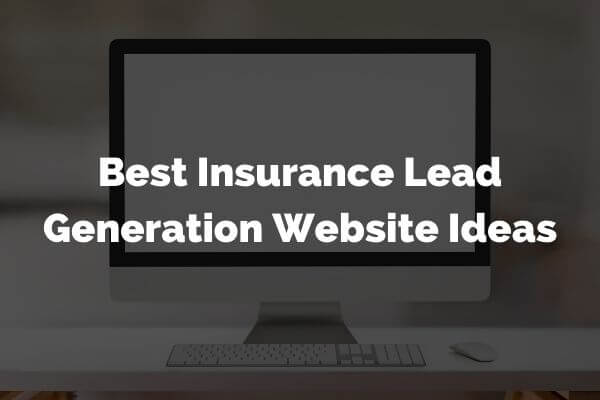Best Insurance Lead Generation Website Ideas
Online lead generation is essential to insurance companies, whether you provide life, motor, home, or business insurance. Regardless of which type of insurance you’re offering, generating more leads online requires ongoing adjustments to your online marketing.
The following are some of the best insurance lead generation ideas.
- Targeting
- Build Website and Landing Page
- Organic and Paid Traffic
- Contact Form
- Call to Action (CTA)
- Tracking
- A/B Testing

Targeting
When generating leads in insurance, identify the target demography that you want.
Align your marketing and lead generation strategies with the prospect life stages, especially around major life-changing events. Customize your campaign and funnel to match the audience you are targeting.
Here are some audience segments recommended for insurance leads:
- First career
- Newlyweds
- New parents
- New drivers
- First-time homeowners
- Landlords
- Retirees
Build Website and Landing Page
Website and landing page are the most critical part of your lead generation strategies and tactics. Here is where we convert visitors to leads by capturing contact information and email subscribers. It’s recommended to create a clean website design that’s informative and easy to navigate.
The main difference between a landing page and a website is that websites have a homepage and other pages that contain multiple sections of information and offerings. Information overload might confuse and frustrate the visitors such that they could bounce off the website. However, landing pages are built for specific offers and campaigns with a clear direction of what you want people to do. Another difference is that you would also use landing pages for paid traffic and websites mainly for organic traffic (SEO).
Organic and Paid Traffic
Next, you need to develop your marketing strategy to get organic and paid traffic for your insurance lead generation.
Organic traffic is also known as free traffic, in which the visitors come to your site from sources that you did not pay. For example, visitors performed a search query on a platform such as a search engine like Google Search or social media channel like Facebook. Search Engine Optimization (SEO) is a method to optimize your website to get more organic traffic.
Paid traffic is you have paid for advertising promotion on a platform to get visitors to come to your page. Example of paid traffic is display ads, paid search (or pay per click), social media ads, sponsored content, native ads, and influencer marketing.
Contact Form
Contact form is a section on your landing page or website for visitors to provide their contact information like name, email address, phone number, and more. The lead generation form will need the acknowledgment and consent from visitors for you to email or call them. For that purpose, you can find a sample template for Data Protection Policy here.
Your contact page will have a contact form. Other pages could have a contact form, link to the contact page, or both.
Sometimes a potential client may want to talk to you about insurance, but without giving too much personal information over a contact form. Therefore, list other contact information like your company email address or phone number in the footer of your pages and on the contact us page.
In lead generation campaigns, a lead is a conversion which could be a form submit, phone call, email, or chat message.
Done properly, creating contact forms and listing contact information on your site will increase the success rate of your company’s insurance lead generation.
Call to Action (CTA)
Call to action tells your visitors what they should do next on a page. Your page visitors could be in any funnel stage, like awareness, interest, decision, or action. So place different CTAs to fit specific visitors at the proper positions on the page to let them choose which action to take. Calls to action are some of the best strategies to increase the conversion rate on your site.
Tracking
You must track the performance of your insurance lead generation campaign.
Each marketing platform and landing page in your campaign funnel must have measurable and trackable goals and metrics. For example:
- Return on Advertising Spend (ROAS)
- Cost Per Action (CPA)
- Cost Per Click (CPC)
- Traffic sources
- Demographic
- Device (mobile, desktop, tablet)
Then, you can see what strategies are working and optimize the marketing platform and landing page for higher performance and drive more valuable leads.
A/B Testing
A/B testing, also known as split testing, is one of the most common forms of testing to compare two versions of a single variable, variant A against variant B, to determine which variant is more effective.< /p>
You can use A/B testing to test the marketing and page elements in your lead generation campaign, such as:
- Promotion strategy
- Copywriting
- Headlines
- Descriptions
- CTA text copy, color, size, and location
- Page layout
- Video versus image
- Traffic sources
- User demographic
- User device (mobile, desktop, tablet)
Preferably, A/B test one element at a time and move the winner forward. Use the winner as a control in a new experiment and try to beat it with a different variation. Test constantly and the more you test, the closer you are to getting as many leads as possible and optimizing the campaign.
You want to run each split test until you reach over 95% statistical significance and make sure you have at least 1000 conversions before stopping the test.
Conclusion
The best lead generation system is results-driven and integrates the website and marketing channels seamlessly to provide the best ROI.
If you are looking for more information, Whotoengage is an experienced lead generation agency that’s been providing lead generation service for years.
Learn more about how we can help you by contacting us today!
